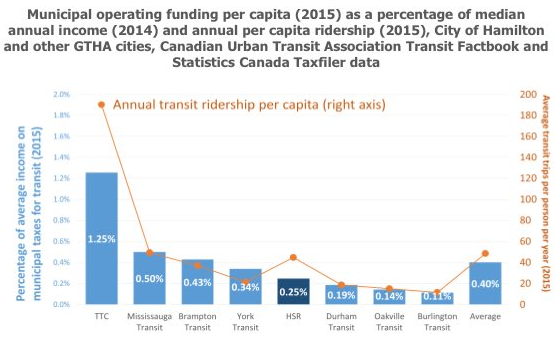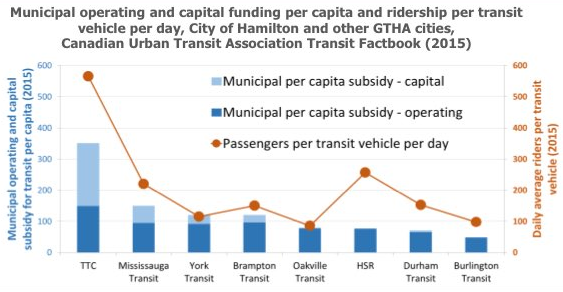The best time to have had this discussion over who should operate the system was two years ago, when Council was signing the Memorandum of Agreement.
By Ryan McGreal
Published July 05, 2017
This article has been updated.
Ward 3 Councillor Matthew Green wants Hamilton's public transit service to operate the Hamilton light rail transit (LRT) line once it is operational.
Councillor Green plans to bring a notice of motion to the August 9, 2017 General Issues Committee directing city staff to "advise Metrolinx that HSR should operate and maintain the new LRT line and any other future transit expansion in the city" and to ensure that the operating agreement between the City and Metrolinx confirms this.
This comes in response to a recent campaign and petition by Local 107 of the Amalgamated Transit Union (ATU), the union representing HSR employees, calling on the Province to have HSR operate the LRT.
The Metrolinx procurement model for Hamilton's LRT system is to contract the work to a consortium that will design, build, finance, operate and maintain (DBFOM) the system for the life of the contract (likely 25 or 30 years). This model was specified in the Memorandum of Agreement [PDF] that Council approved in February 2016.
The LRT assets themselves - the infrastructure and rolling stock - will be owned by Metrolinx, a Crown agency, and remain in public hands permanently. However, the operation and maintenance will be contracted to a private company over the course of the contract term.
The position Metrolinx takes is that it will not consider having the municipality operate a Metrolinx LRT project unless the municipality already has experience running a rapid transit system. For example, in Toronto the TTC is expected to operate and maintain the Eglinton Crosstown LRT system once it commences operation in 2021.
Metrolinx issued a Request for Qualifications (RFQ) for the Hamilton LRT on February 2, 2017, inviting interested consortia to apply to be allowed to bid on the actual project. From the list of applicants, Metrolinx will select a shortlist of organizations that are deemed qualified to build and maintain a project of this size.
That shortlist of qualified applicants will be invited to submit a bid through a Request for Proposals (RFP) process, which will commence once the LRT Environmental Project Report (EPR) has been approved by the Ministry of Environment and Climate Change.
The City and Metrolinx submitted an EPR Amendment to the MoECC on May 29, 2017. It was made available for a 30-day public review period ending June 28, followed by an additional 30-day window for the Ministry to consider any objections to the project on environmental grounds.
You might remember the EPR amendment vote, which generated a spot of bother when Council spent several weeks agonizing over whether to approve it at all or let the entire LRT project die after voting for LRT literally dozens of times since 2007.
I don't think it's lost on anyone that HSR stands for "Hamilton Street Railway." The HSR literally started out as a streetcar operator, running 45 km of street railway on seven routes before the 1950s.
However, necessary investment in maintenance was neglected during the 1930s and 1940s, and the Ontario Hydro Electric Power Commission sold the HSR to Canada Coach Lines, a bus company. (HSR didn't come under public ownership until 1960, when the City of Hamilton bought Canada Coach Lines.)
Starting in 1951, Canada Coach Lines quickly abandoned the streetcar routes, replacing them with electric trolleybuses. The last trolleybus route on Barton was decommissioned in December 1992 and the HSR has operated entirely on buses ever since.
There is certainly a case to be made for the benefits of having both LRT and local transit operated by the same agency. The HSR has the capability of acquiring the expertise it needs to operate and maintain LRT, and having the same administration coordinate both services means they can be more tightly integrated - at least in principle.
I strongly support unionization of the operations and maintenance employees so they can bargain for fair, living wages, and encourage the ATU in its efforts to organize the employees of whatever agency ends up receiving the operation and maintenance contract.
What strikes terror into the hearts of many LRT supporters is the idea that it might fall under the direct control of Hamilton City Council, which has a dismal 30-year track record of overseeing public transit in Hamilton.
City Council regards transit as a social service for the poor, not a legitimate part of the city's transportation network. HSR budgets have been left stagnant or cut nearly every year for the past three decades with management and staff left undermined and demoralized at every turn.
Countless planned transit improvements have been stalled, scaled back or cancelled altogether, and transit ridership has fallen steadily in both absolute terms - from 30 million rides a year in the 1980s to just 21 million rides a year now - and especially as a share of total trips.
While other big cities across Canada and North America have seen transit ridership grow significantly over the past decade (notwithstanding the past year), Hamilton's transit ridership has continued to stagnate or fall. Our share of the Provincial Gas Tax, which is calculated in part based on growth in ridership, has continued to shrink year after year as other municipalities pull ahead.
Our federal gas tax is supposed to be spent on transit, but Hamilton sinks nearly all of it - $30 out of $33 million a year - into road maintenance instead.
Just this past spring, Council voted to delay implementing year three of its own Ten Year Transit Strategy after Councillors spoke passionately about the need to increase transit service (even Councillors who voted against LRT).
This would have been the first year in which Council invested new public dollars into transit after two years of draconian fare increases that were sold on the promise of increased service but actually resulted (predictably) in ridership declines.
To put it bluntly, many LRT supporters fear an outcome in which LRT ends up under-funded, under-staffed, under-serviced and mismanaged, its vehicles blanketed in opaque vinyl ad-wraps and their interiors festooned with PSAs for lead water pipes and sexually transmitted infectious diseases.
Again, to be entirely clear, this is by no means a criticism of the HSR employees who actually operate and maintain the transit system. As Sara Mayo of the Social Planning Research Council points out, the HSR does an exceptional job of running a cost-effective transit operation, despite being chronically under-funded.

Chart: Municipal operating funding per capita (2015) as a percentage of median annual income (2014) and annual per capita ridership (2015), City of Hamilton and other GTHA cities (Image Credit: Social Planning Research Council

Chart: Municipal operating and capital funding per capita and ridership per transit vehicle per day, City of Hamilton and other GTHA cities (Image Credit: Social Planning Research Council)
But that in itself just underscores Council's poor record of funding and supporting its own transit system, compared to other GTHA municipalities.
We could only support a push to have the HSR operate LRT under the following necessary conditions:
1. The policy must be implemented without threatening the LRT implementation timeline. The RFQ has already finished and the RFP is expected to go out at the end of this month. This timeline is essential to get a contract signed - with cancellation penalties - before the next Provincial election so that project cannot be cancelled at the last minute by an incoming government with a different set of transportation priorities.
2. The HSR LRT operations and maintenance contract would have to specify that HSR is directly accountable to Metrolinx for its funding commitment and service level agreements, with no capacity for Council to renege on its financial commitments or starve the service for resources.
If it is possible to negotiate such an agreement that protects the integrity of the LRT system without threatening the implementation timeline, it is certainly worth carefully considering. Those are two very big ifs.
This last-minute curveball could just as easily turn into yet another political fiasco that threatens the entire investment. It is a certainty that LRT opponents on Council and in the community are already looking for opportunities to use this to stall, obstruct and ultimately kill the project.
The best time to have had this discussion over who should operate the system was two years ago, before Council signed the Memorandum of Agreement. There may be no harm in Council exploring the option today and asking Metrolinx to consider it, but not at the risk of threatening all the hard-won progress this endlessly-contentious project has made to date.
Update: Councillor Green was originally planning to bring the notice of motion to the July 10, 2017 General Issues Committee meeting. Today, Green's office issued the following statement: "Pursuant to Council direction that all matters related to LRT go to either LRT Sub-Committee or a Special LRT GIC, Councillor Matthew Green’s Notice of Motion to Keep LRT Public will be heard at the Special GIC on LRT on Wednesday, August 9, 2017."
By AlHuizenga (registered) | Posted July 05, 2017 at 12:20:37
Does Metrolinx specify that the winning bidder must have a unionized workforce? Could it? The Bombardier people operating GO are members of Teamsters Canada...
By JasonL (registered) | Posted July 05, 2017 at 13:27:11
what strikes terror into my heart is that LRT might fall under the direct control of city council, the HSR, and their union.
NO THANKS
By TreyS (registered) | Posted July 07, 2017 at 22:45:47
Question: How do we know the operating costs when we don't even know who will operate it? But magically LRT will be revenue neutral? We know it won't be.
By TreyS (registered) | Posted July 11, 2017 at 14:32:10
Placating to Unions won't help you get a future NDP seat. O wait, it will.
You must be logged in to comment.
There are no upcoming events right now.
Why not post one?